Because of recent events, there are more reasons than EVER to learn how to build an affiliate website!
As you may know, many of the most successful ClickBank affiliates have focused on media buying through platforms like Google and Facebook over the years… but the times, they are a-changin’.
Why You Need an Affiliate Website
In the heyday of Facebook Ads from around 2015-2018, you could jump into the Ads Manager, set up some new ads, and point cold traffic right to an offer – no website needed!
But after the iOS 14 update in mid-2021, Facebook has changed. As an affiliate, you’re only allowed up to 8 conversion data points with Facebook Ads – and with so many iOS users opting out of tracking, you can’t get as granular with your audience targeting anymore. Plus, one of the biggest changes is that you need a “verified domain” for your landing page on Facebook Ads.

Aside from this, the growing trend toward greater online privacy means that affiliate marketing is becoming less transactional and more relationship-oriented. In other words, creating a recognizable brand and reputation that people trust will play a bigger part in your success as an affiliate!
So, whether you’re looking for more control over your affiliate marketing business in the long run or you just need a halfway decent website to satisfy ad platforms like Facebook, now is the perfect time to build an affiliate website!
How to Create an Affiliate Website That Makes Money
In this epic guide, we’re going to focus on how to create an affiliate website with WordPress, one of the most popular content management systems on the market.
There are alternatives for making a website, such as Wix or Squarespace – or coding your own site from scratch – but WordPress offers a solid balance of usability and versatility to fit anyone’s affiliate business. (It’s also totally free… But you should use what works best for you!)
Ultimately, there are a ton of strategies to promote an affiliate link – and you should consider ALL of them on your affiliate marketing journey – but in this post, we’re focusing specifically on how to set up a product review website with SEO content.
Ready? Here are the 5 steps to building an affiliate website!
Step 1. Pick Your Niche as a New Affiliate
If you don’t already have a niche in mind for your affiliate marketing business, you’ll want to decide on one before you build your website!
As a reminder, a niche is just a narrow topic area or audience for your website. Here are a few examples found on ClickBank’s marketplace:
- Copywriting
- Cryptocurrency investing
- Parenting
- Men’s health
- Diets & weight loss
- Travel
- Music
- Astrology
These categories can be broken down even further in a process called “niching down,” where you get incredibly specific in your topic area. Some affiliate marketers swear by creating so-called “authority sites” that cover a much wider range of topics within the same niche.
For example, if you’re interested in the pet space, you could make a very niche website just about “dog food,” or you might build an authority website about “dog care” in general, including topics about dog food, but also areas like grooming, training, and pet supplies.
Both approaches can work – just make sure you’ve decided which one makes more sense for your business. And be careful not to get too specific (ie a site about “organic dog food for schnauzers”) or too broad (ie a “dog hub” for all things dog).
Here are a few other factors to consider when choosing a niche:
- Is it evergreen? Seasonal niches aren’t as easy to build and monetize, and temporary niches that are based on fads or trends may not be worth the effort to build a full website around. Focus on a niche that will still have demand for at least 3-5 years.
- Can you monetize it? Almost everyone with an internet connection is interested in health, wealth, and relationships, but extremely niche topics (like Ancient Egypt history, for example) probably won’t have enough demand or broad appeal to support a successful affiliate business.
- Do you care? You don’t have to love everything about your business, but if you don’t like your chosen topic at all, it’ll be hard to stick with it long enough to see success.
One of the most important steps in niching down is scoping out which affiliate offers you’ll be marketing. As an affiliate, it’s your job to connect buyers to the digital or physical products they’ll be interested in – you need both for your business to work!
You can do this on all kinds of affiliate networks (including ClickBank’s marketplace – sign up for free!) or by applying directly to affiliate programs from companies in your niche. One way to find potential products or a promising affiliate program is to scope out competitors’ sites to see what they’ve got in their marketing content, or just search “best ____ “ with product categories in your niche.
In this case, let’s choose the niche of health and fitness for women over 50. As far as the name of your site, you can either choose a relevant keyword or come up with a brand that encompasses the topic.
For our new affiliate website, let’s call it Health After 50.
Step 2: Get your Site’s Domain and Hosting
Once you’ve chosen your niche and a name for your site, you need to register the domain and choose a host. This is a simple step, but it can have big implications for the success of your affiliate site.
Your domain is the URL where people will find your website online, so it’s important to give it some thought. I would recommend only using a .com extension, although some marketers get away with alternatives like .io or .info.
For domain registration, I’ve used both GoDaddy and Namecheap – and sometimes, a web host will give you a free domain if you buy hosting from them, so that’s an option too.
Here’s what it looks like if we go with Namecheap!
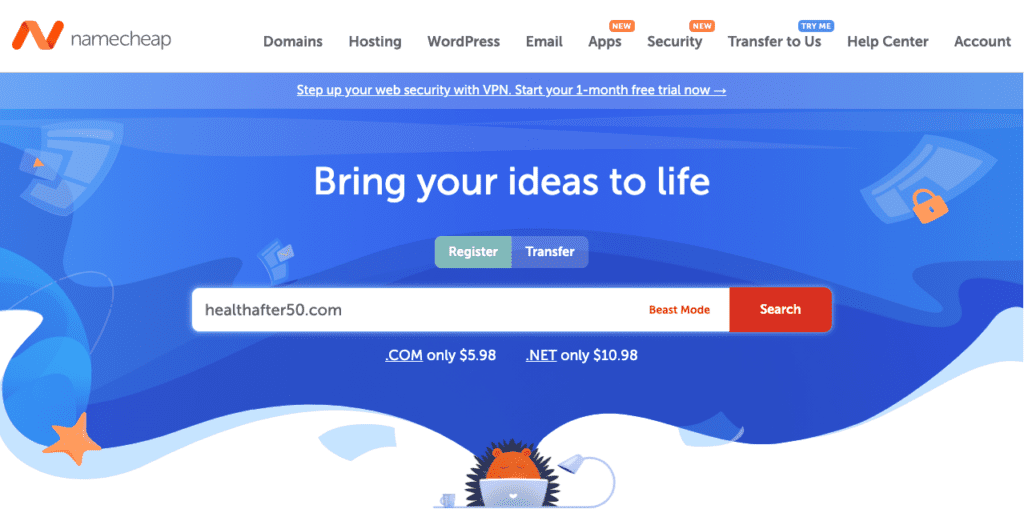
Next, we’ll want to choose a web host. Everyone has an opinion on which web host is best, but that’s partly because everyone has different needs. If you’re hosting a massive ecommerce store, your host needs to be more robust than someone with a modest content site.
Siteground and WP Engine are both powerful and versatile web hosting services for your WordPress affiliate site, but expensive too. For anyone who’s starting out as an affiliate and needing something solid, but affordable, I really like Bluehost. (In fact, I’ve used Bluehost for my own content sites – including Improve Songwriting – without any issues.)
To get hosting for our new affiliate site, we can go to Bluehost and hit the “Get Started Now” button. Bluehost includes a free domain and a one-click WordPress install for $2.95 or $4.95 per month!
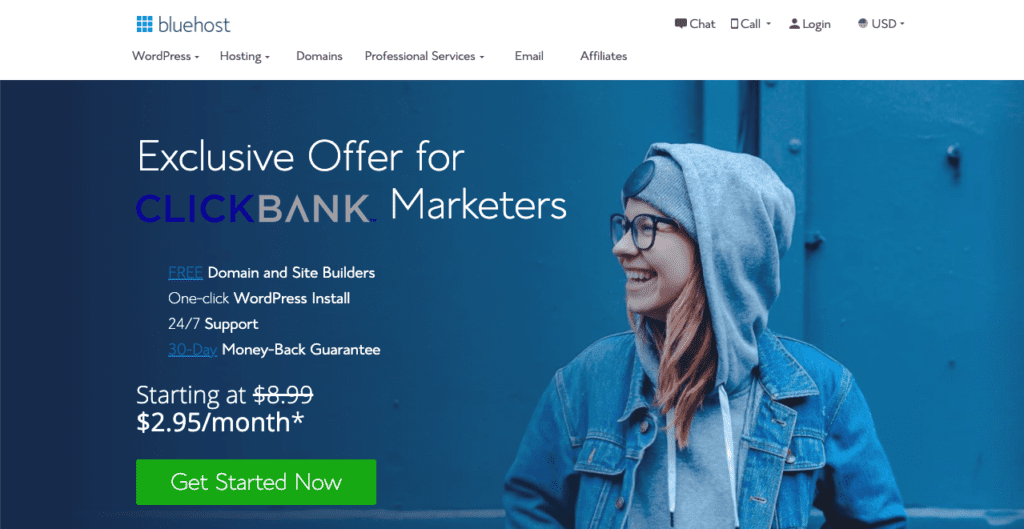
If you want to follow along in creating your site as I do it, you can view all Bluehost pricing and plans here. Get 43% off using our link!
Once you’ve selected your plan and made a purchase, you’ll be able to set up your new website with WordPress!
Step 3: Set Up Your WordPress Website
If you went with Bluehost in Step 2, you’ll be able to build your WordPress site easily and quickly, even without a ton of website experience.
First, many hosts have one-click WordPress installs. You can just click the button and the host will make sure WordPress is ready to go in just a few minutes!
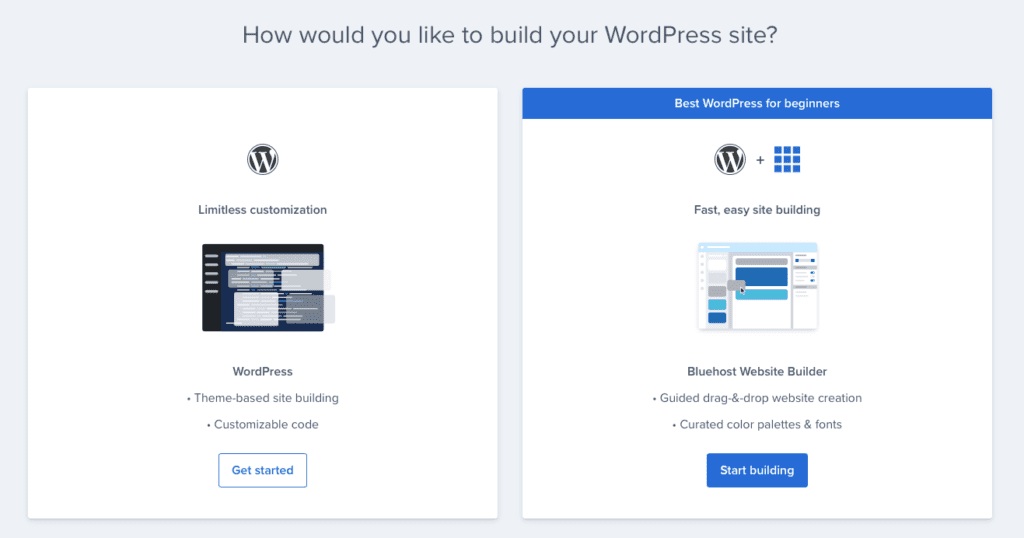
From there, you’ll want to pick a WordPress theme that can support a professional-looking affiliate website.
In my experience, there are three WordPress options that work well for affiliates:
- GeneratePress with Elementor Pro. GeneratePress is a lightweight theme that runs really fast – perfect for SEO and user experience. Elementor Pro is a versatile WordPress page builder that plays nicely with most WordPress theme (GeneratePress included). Most importantly, these both have free options – but if you opt for more advanced features, this is a powerful combination for under $100 per year for one website.
- Thrive Themes Membership. If you’re farther along in your business and ready for advanced features, I would look into Thrive. It bundles a lot of different plugins and features under a single monthly membership of $19/mo, which is quite reasonable – it’s possible to cover that bill with just one affiliate commission per month!
- Divi. Divi is a combination of theme and page builder in one. It’s easy to use – like Elementor, you have the ability to see what the page will look like as you build it. Lastly, I like Divi because there’s a lifetime membership option for $249 that you can use on unlimited sites forever!
To install a new theme, first purchase it on the theme’s website and download the Zip file where you bought it, then hop into your WordPress dashboard and upload it there.
Go to Appearance > Themes > Add New and then click “Upload Theme” to get started. Follow the instructions and it should finish installing in just a few minutes.

If you need to install a separate website builder plugin like Elementor, the process is similar, just under Plugins > Add New.
Now, to set up your new website, you’ll want to customize a few things:
- Logo
- Favicon
- Font
- Brand colors
- Header and footer
- Blog archive page
Most of these elements can be controlled in your premium theme’s Customizer (found under Appearance > Customize). If the theme doesn’t have one, check the documentation for other places where you can make these tweaks to give your site some personality.
No need to go overboard on customization, though – these are all things you can change later!
Next, you’ll want a handful of free or inexpensive WordPress plugins to get you started:
- An SEO tool like Rank Math SEO or Yoast SEO
- A caching tool like WP Cache or WP Rocket
- A lead capture tool like OptinMonster
- A form builder like Gravity Forms or WPForms
- An affiliate link management tool like Pretty Links
- An ecommerce store like WooCommerce (if you want to sell your own products)
- A membership site plugin like Wishlist (if you want to monetize your site with memberships)
This isn’t an exhaustive list, and everyone will find a combination of plugins that work best for them – but that’s exactly what makes WordPress so versatile. You can find plugins for almost any functionality you need, often for free!
Last but not least, you’ll want to set up your individual pages. A real niche website will have at least the following:
- Home page
- About page
- Contact page
- Disclaimer/privacy policy page
- Blog
Many affiliate websites also have a “tools” or “partners” page where they list out some of their recommended resources as affiliate links.
For example, on our Health After 50 affiliate website, we can include some of our products targeting women over 50. These include ClickBank marketplace products like “Yogaburn” for exercise and wellness or “Back to Life” for back pain relief.

For most basic content sites, these are the only pages you need! You can create them in your WordPress dashboard by going to Pages > Add New. Many premium themes and page builders even come with templates or assets to help you finish your pages faster!
Once the pages are all ready, you’ll be wondering: What’s next?
Well, I would recommend making sure you’ve connected your site to Google Analytics and Google Search Console to help with tracking. Analytics will allow you to see what kind of traffic you’re getting and where it’s going. Numbers and data will allow you to make the best decisions for your affiliate marketing business.
But at this point, the site is up and running. Now, it’s time to finalize which products we want to promote on our site, so we can produce the content we need to start making money!
Step 4: Choose Affiliate Products to Promote
Experienced affiliate marketers will often have a clear idea which products are available to promote in their niche – but as long as you’ve picked an in-demand niche, you’ll always be able to find new offers.
So, now that our Health After 50 site is up and running, we need to go find some products!
As I mentioned before, you can easily find products online by looking at competitors’ sites in Google. We also have plenty of great health and supplement affiliate offers right here on ClickBank’s marketplace!
Let’s walk through how you can find products with both methods.
Method 1: Searching for Product Ideas in Google
One helpful way to find potential affiliate products to promote is to search for them right in Google. The cool thing about this method is, it doubles as keyword research – if you discover that the search results are lean for certain queries, you may have an opportunity to create a quality piece of content to address that need.
For our site, I started with a really broad search: “products for women over 50.”
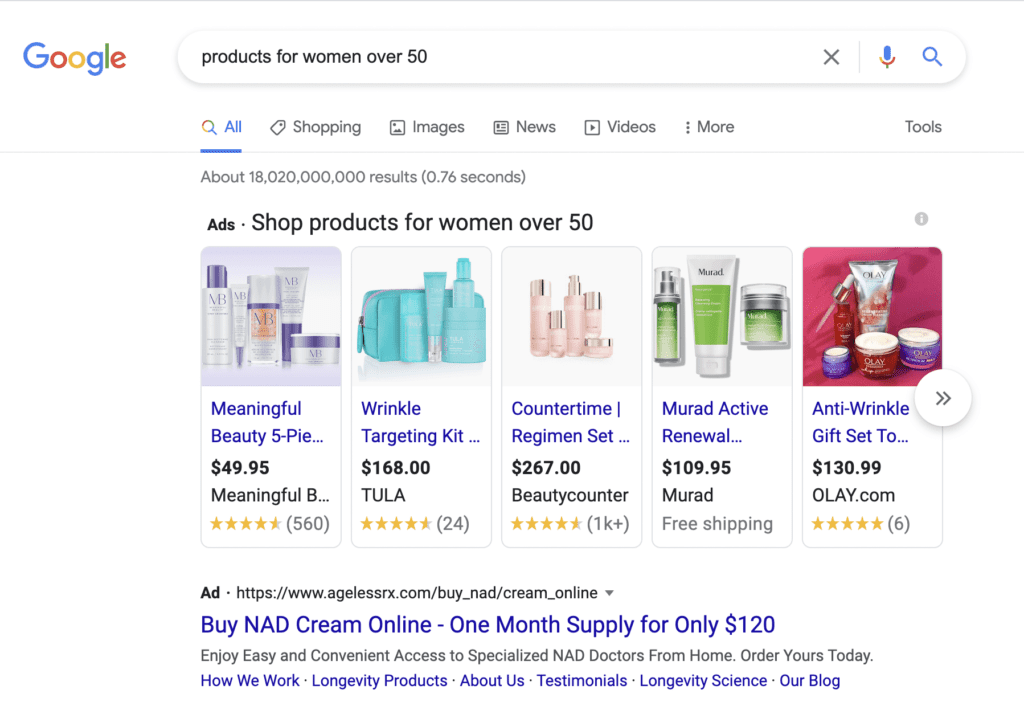
Immediately, I noticed a range of topical cream ads show up at the top of the SERP – and health-related creams were an angle for our audience that I hadn’t thought of yet!
I kept going down this track by searching for “best anti-wrinkle cream for women” and checking the results for that.
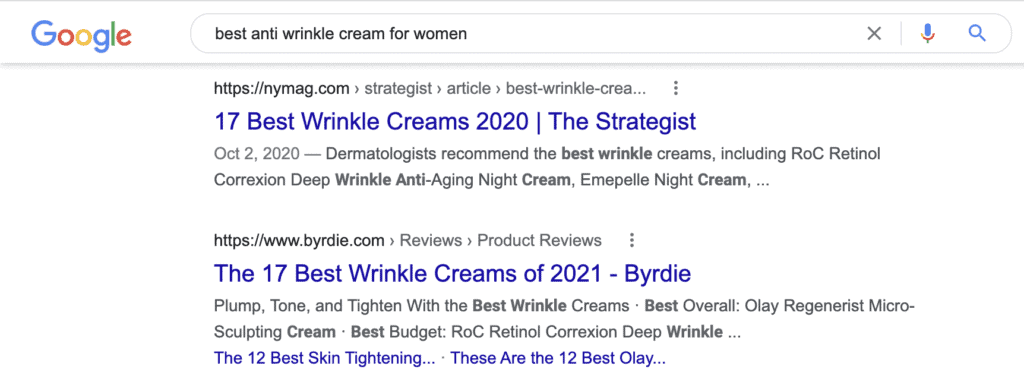
The search results included several “list articles” with affiliate links to these products. Most of the websites here are our competitors, at least for this category of affiliate product. We also uncovered “anti-aging cream” as a helpful variation of the search term I first used.
If we click through to some of the competitors’ sites in these search results, we’ll start to see specific brands and products that might be relevant for our own target audience.
For example, in one anti-aging cream article on Today.com, I noticed this item with affiliate links to Amazon and to another website called Dermstore that sells creams.
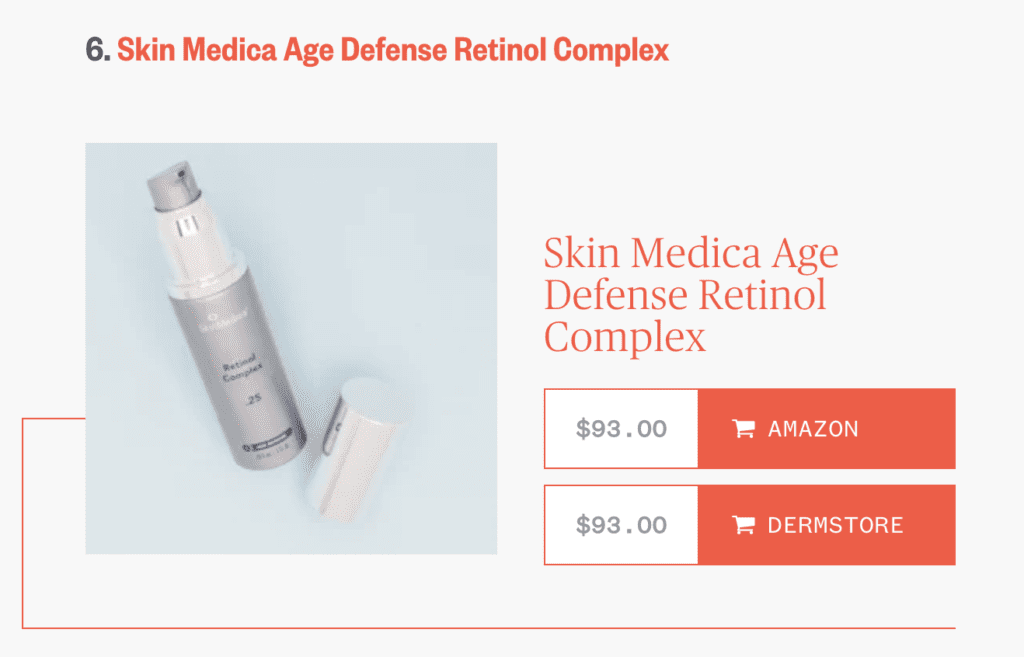
With this information, I’ve now discovered a brand called Skin Medica, plus a store called Dermstore that might have a perfect affiliate program for our new website! A little extra research shows that you can be an affiliate for Dermstore if you sign up through FlexOffers.com.
As you can tell, all of this takes a bit of legwork, but Google research can give you a ton of information on competitors, keywords, affiliate programs, and of course, affiliate brands and products to promote.
And when you see what other sites are doing to monetize their content, you’ll get ideas that are likely to work well for your site too!
Method 2: Finding Products to Promote on ClickBank
The other method for finding products is to go directly to an affiliate marketplace with offers available to promote, laid out by category.
In our case, Health After 50 is in the health and fitness niche, but it’s broad enough to cover a lot of different categories.
I signed into my ClickBank account to get started (and you can follow along by signing up for ClickBank here – it’s free!).
After jumping into the ClickBank marketplace, I started with a quick search for “women” to find some products made for women.
Before long, I came across two interesting offers that might be worth promoting:
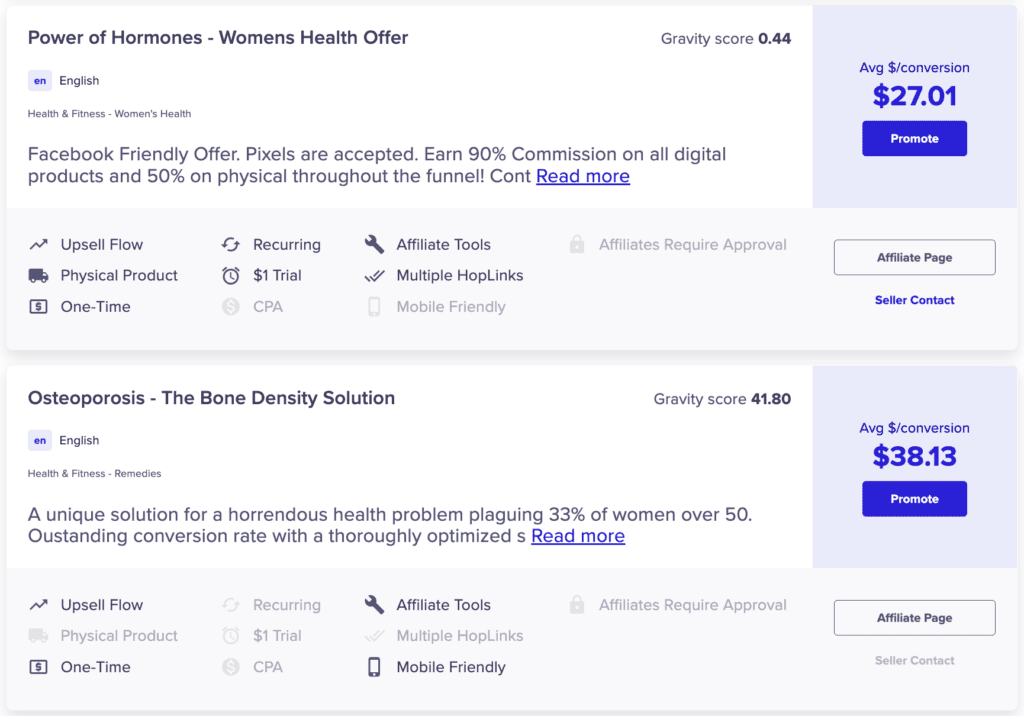
One is a women’s health offer called “Power of Hormones,” and the next is a bone density offer called “Osteoporisis – The Bone Density Solution.”
You can see the Avg $/conversion to give you a sense of how much you’d usually make on each sale of these two products. Also notice the Grav. number at the bottom – the product’s Gravity Score tells you how popular a product is, to help you decide if a product is worth promoting.
Instead of doing a search on the marketplace, I could also just navigate through the health and fitness categories to find the subcategory of “Women’s Health” there. The results on this page include health offers like Yogaburn that are tailored specifically for women.
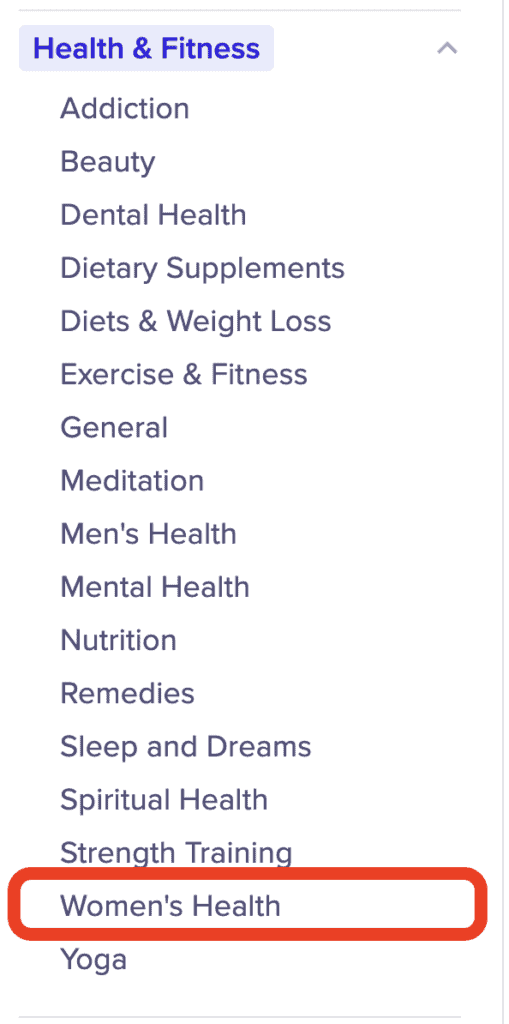
If I want to promote one of these women’s health offers on my Health After 50 site, I have a few options:
1) I can write informative content on the site with the goal of building a targeted email list of women over 50, and then promote these offers to them via email.
2) I can sprinkle these affiliate links into my content and grow my search traffic to make commissions from organic site visitors (more on the type of content you should write in a bit).
These are both viable ways to promote top ClickBank products on your affiliate site!
With that said, there are all kinds of places to find affiliate products you can write about on a content website. ClickBank is one great source, but you should also be aware of affiliate programs like Amazon Associates. It’s a balancing act, because the vast product selection you get as an Amazon affiliate is helpful, but the commission rates on ClickBank offers are MUCH higher (which means your typical payout is much higher as well).
Ultimately, you have to decide which route will make you the most money – or just use more than one! For detailed information on how ClickBank and Amazon compare, check out our in-depth guide on ClickBank vs. Amazon.
Step 5: Create Regular Website Content
Now that we’ve found some offers we like, it’s time to produce content for our site. This content will live on the site’s blog – you can easily create a new post in your WordPress dashboard by navigating to Posts > Add New.
To make money on an affiliate site, your best bet is to find “buyer intent” keywords to target with your articles. Here are a few examples:
- Best anti-aging creams for women
- iPhone vs Galaxy phones
- Which stocks should I buy?
- Cheap BBQ grills
Any user actively searching for terms like these is likely to make a purchase if they find something they like. The nature of the search term indicates an intent to buy.
As you write content around these buyer intent keywords, you’ll add affiliate links into your content whenever you mention a relevant product. (And don’t forget an affiliate link disclosure!)
The 3 Primary Types of Affiliate Content
Here are the 3 types of affiliate content you’ll be producing for your content site:
- Product review posts (x review)
- Product comparison posts (x vs y)
- Buying guide/roundup/listicle posts (x best ____)
You’ll also want to create informational content that provides insane value to readers! These are sometimes called “pillar posts,” and they do a few important things:
- They prove to Google and your readers that this is an actual website, not just a place to spam a ton of affiliate links.
- They tend to be more popular than affiliate content, so pillar posts are great for winning backlinks from other sites.
- They can be effective bridge pages for traffic from a paid ad or email campaign (ie a midpoint destination in your funnel that then points to your offer page).
Creating Review Articles as an Affiliate
So, how does creating a successful piece of affiliate content actually work in practice?
For Health After 50, we’ve already found a few products that we’d like to promote. To come up with a piece of content, we just have to think about the product category one of the products falls into.
For example, if we wanted to write about getting rid of cellulite for women to promote My Cellulite Solution, here are a few blog post examples:
- Product Review. My Cellulite Solution Review: Does It Really Work?
- Roundup Post. The 13 Best Anti-Cellulite Products That Work
- Pillar Post. How to Get Rid of Cellulite – 100% Natural Methods!
These are all based on keywords we want to target: “My Cellulite Solution review,” “anti-cellulite products that work,” and “how to get rid of cellulite.” All of them would be good to rank for if you’re looking to promote My Cellulite Solution on your product review site.
I highly recommend doing keyword research to find the search terms you have a shot at ranking for. My favorite SEO tool is Ahrefs, but you can also use SEMrush, Mangools, Ubersuggest, or any other search tool that you prefer.
The topic of keyword research is too involved to cover fully here, but try to find long-tail search terms of 3-5 words that have a decent search volume (ideally 1000+), and not too much competition. You can check competition by looking at a site’s domain rating in Ahrefs and comparing it to your own.
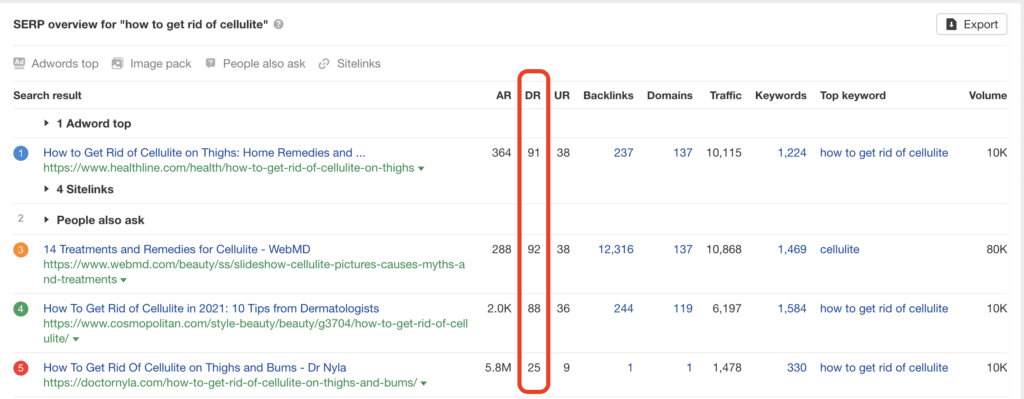
I generally wouldn’t bother trying to rank for a term if there isn’t at least ONE competitor in the top 10 with a domain rating lower than yours, unless you’re prepared to do a LOT of link building after the fact!
(For more information on ranking your SEO content, please visit our on page optimization guide about LSI in SEO.)
Ultimately, you’ll want to create affiliate content that ranks in Google and automatically brings in visitors who convert into customers. The affiliate site is a doubly powerful tool if you can capture emails and use an email service provider like Sendlane to get new offers in front of your audience on a regular basis.
For example, with Health After 50, if we get some visitors to subscribe for more content, then we can send out valuable, inspiring, and entertaining content to our audience of older women every week – and still recommend products to them that lead to sales!
With affiliate email marketing, you’re creating a relationship with the audience so they come to trust your advice, which includes product recommendations. That means more commissions and a stable business that can grow over time.
Next Steps: How to Build an Affiliate Website Wrap-up
At this point, we’ve finished creating our Health After 50 affiliate site!
It’s got a web host, a premium WordPress theme, a few ClickBank products to promote, and some published affiliate content working to drive commissions for us. It even has an email list started as a way to communicate directly to our audience and promote future offers.
So… what now?
Well, there’s good news and bad news!
The good news is, you’ve got a world of options to choose from…
But the bad news is, you’ve got a world of options to choose from!
That’s right! Now that you have an affiliate website as a base of operations in your chosen niche, you can:
- Double down on affiliate SEO content and build toward an authority site that generates thousands per month in affiliate commissions and display ad revenue.
- Use your website to build an email list and promote affiliate offers there.
- Focus on paid ads or YouTube now that you have a decent niche website with a verified domain – you can easily host landing pages and bridge pages on your site as needed.
- Take everything you’ve learned about your niche along the way to create and sell your own product (just add an ecommerce store using a plugin like WooCommerce and you’re in business).
- Sell the website to a third party for a tidy profit.
In the end, there isn’t only a single route to success with affiliate marketing, but building your own niche website is a fantastic starting point that opens up all kinds of possibilities for your business!
I hope this guide on how to build an affiliate website has given you a solid roadmap for the affiliate marketing success you’re looking for!
For more about how to succeed as an affiliate marketer, check out our full ClickBank for Beginners guide. I also recommend checking out ClickBank’s Spark certification program. It takes you step-by-step through everything you need to know to make an income online!






